A frenzied eruption of white birds from the shallows of the distant shore caught my attention. A wedge of seven white ibis have been visiting the resaca for a couple of weeks and as yet, their shift to various parts of the resaca has been smoother — a more orderly decampment displaying vestiges of an ancient, predetermined flight formation — so this disorderly scattering was significant.
I spied the culprit. An animal was leisurely walking along the bank at a sedate but steady pace, like a dog with no particular destination. Its coloring was the tawny taupe of a weimaraner but its head was more the shape of a boxer dog. I’d been working in our sunroom and know dogs frequent that shore but out of an innate curiosity I thought I’d best take a gander at the activity through the binoculars — you never know . . . .
I darted to the kitchen and grabbed the binoculars off the hook near the kitchen sink window. I quickly focused across the water and experienced a sudden frisson of delight — a bobcat!
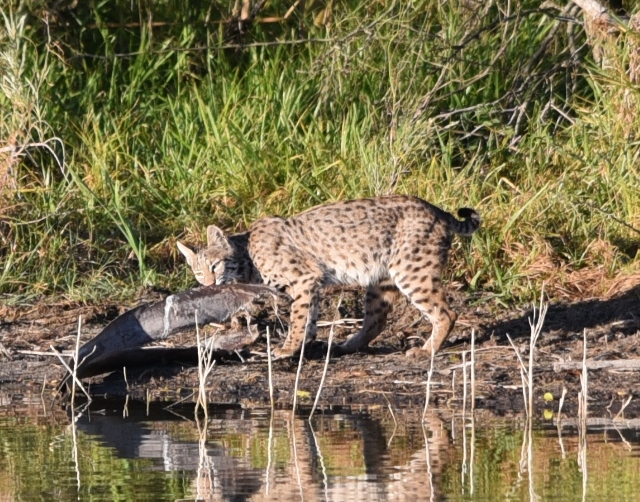
I grabbed the camera with the long lens — which also lives near the kitchen window for just such a purpose. I snapped a couple of shots through the window and then raced out doors for more photos.
From the first spotting of the animal to the last shot, not more than 10 minutes elapsed. During that time, the bobcat meandered along the bank, investigated a tunnel through the thicket, returned to the shoreline, strolled to the beached blackened remains of a cast off palm leaf sheath, sat on its haunches, posed like it was displaying the robes of state, looked around, crouched, hissed, arose, and when the shadows of five flying whistling ducks passed over the kitty’s head, it leapt around and scarpered off into the thick brush. I waited, but it did not return.
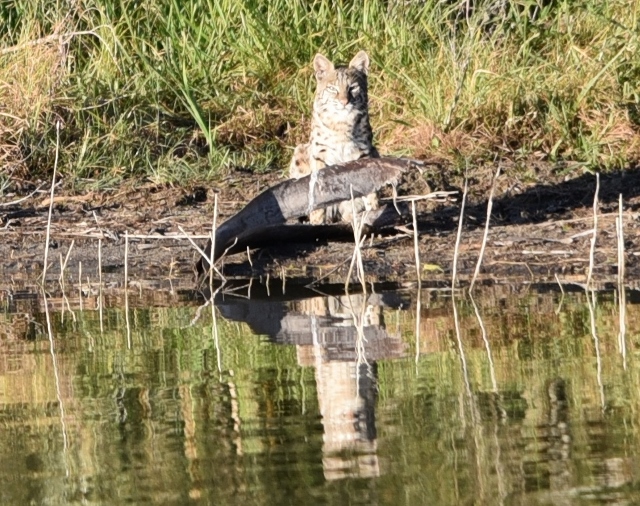
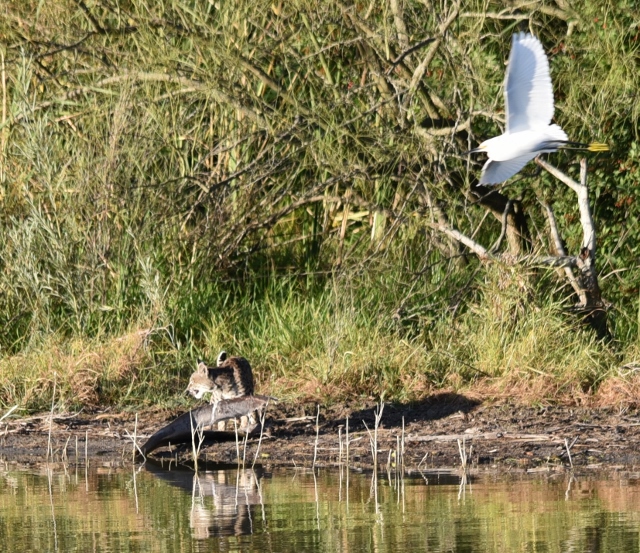
This event was one of those thrills of a life-time — the opportunity to capture a photograph of a suspectedly-impossible bucket-list item. Of course, I now want the opportunity to get better photos and now that I know it might be possible — as witnessed by my limited but important observations — several questions reel through my mind. Like, will this cat pass this way again? Are there more than one? Is there a whole family of them? Are our two cats safe? The bobcat looks awfully well fed, is it pregnant? I spent the next morning reading about bobcats and specifically, bobcats in Texas. I’ve noted the sites I used to write this post at the end.
A bobcat will stalk, hide behind a structure, crouch, wiggle its hindquarters, pounce, leap and purr just like the family domestic cat — but do note — no matter how cute, bobcats are wild animals! Even those bobcats that people have tried to domesticate from kitten hood will always and forever be wild, according to many of the articles. They can’t help it; it is, after all, their nature.
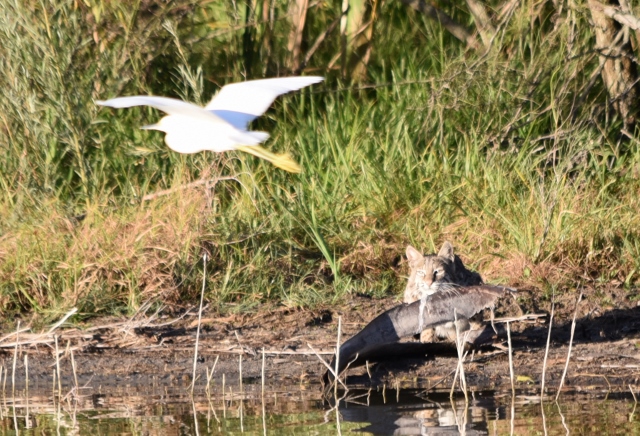
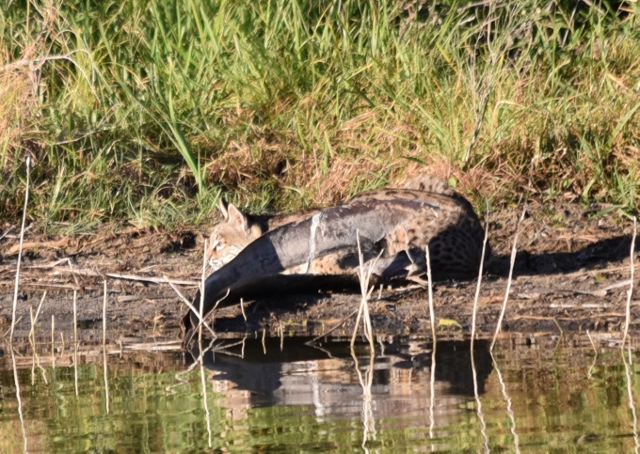
The research has somewhat answered my initial questions: Bobcats are solitary and territorial. They rarely cross each other’s paths except during the mating season which begins in February; gestation is 50 to 62 days, and one to six (normally two) bobkittens are generally born in April and May.
As for being territorial, a bobcat’s range size varies, depending on availability of suitable prey, season of the year and habitat composition. My husband pointed out that here in the county, outside San Benito, their range is segmented by crops, sections of thorn scrub, roads, irrigation and storm ditches, resacas, a smattering of businesses and homes with yards and acreages of carpet grass. However, none of that is a problem to this “highly adaptable animal that has coped well with human settlement,” according to a Texas Tech University article.
Female bobcats may have a territory range of about six square miles, according to one source; males as large as 30 to 60 square miles. A male’s territory can overlap several female territories. Bobcats are polygamous. They do not mate for life.
These cats may have quite an extensive home range, but they do not use all of their territory; they have preferred, established and circuitous travel routes. Likely, they return to a particular point on their route every week to three weeks. But I have more questions: Just how much a creature of habit are they? Will the bobcat be back, again on a Thursday, in this one or three week time frame? Will it be at around the same time of day — around 9 a.m.? I will have to make my own observations.
Interestingly, bobcats will walk dry creek beds and walk openly along banks of live water streams that have adjacent wilderness cover — and apparently along the narrow shore of a thorn-scrub-edged resaca — which gives me hope that I’ll eventually see the bobcat again.
Another source reported that bobcats frequently hunt from roads and trails which was encouraging that we might be on a bobcat circuit. During the April 2020 City Nature Challenge, I had uploaded an observation of scat to iNaturalist.org that was eventually identified as bobcat. That observation was from directly across the road to our driveway where they had reconfigured an irrigation ditch to the water-conservation-underground tubes.
“Adult bobcats are usually 25 to 30 inches long, stand 15 to 20 inches tall at the shoulder and weigh between 15 and 25 pounds. The male and female look alike, but the male will be larger,” according to www.tpwd.texas.gov.
Bobcats are active year round and do not hibernate. They locate enemies and prey by their acute vision and hearing.
Bobcats vary in color but are generally tan, brown or gray with black spots all over and white belly fur. They are two to three times larger than a domestic cat and have a fuller, more muscular body.
Their unique features include:
- Short, black-tipped, bobbed tail
- Tuft of black fur at the top of their pointed ears
- White patch in the center of each ear
- Long white whiskers
- Long jowl fur
- Distinctive black bars on the forelegs
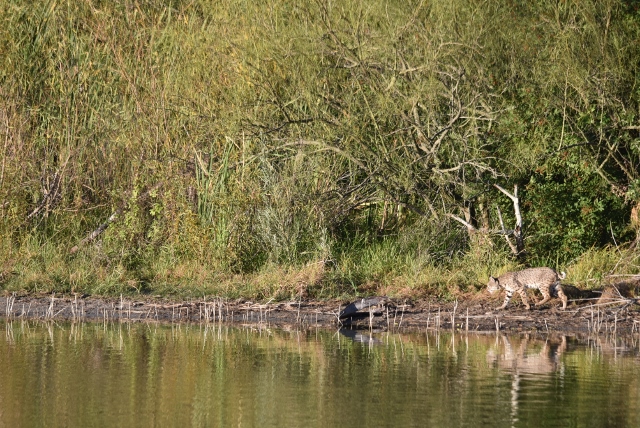
The black ear tufts are important to their ability to collect sound to improve their hearing. They use whiskers like fingertips to help them feel around their habitat and judge whether an opening is big enough to fit through. They have superb night vision. Their powerful hind legs allow bobcats to jump fences over six feet high; they can jump 12 feet and leap 10 feet to pounce on a prey; their top running speed has been clocked at 34 mph. Bobcats are skilled swimmers.
In the family of Felidae and the lynx genus, the bobcat’s binomial name is Lynx rufus; it is a hunter and meat eater.
These medium-sized cats are found only in North America, from Canada through the United States and into northern Mexico. They are the most common wildcat in Texas, roaming freely throughout the state but rarely seen. They are abundant in south Texas. They are shy, preferring to avoid humans.
Bobcats are crepuscular, which means they are most active at dawn and dusk. They begin prowling about three hours before sunset until around midnight and then again about an hour before dawn to early morning. They do the majority of their hunting in low-light conditions.
Their non-hunting hours are spent resting and sleeping in various dens in their territory — of which they may have several; a den might be a hollowed-out or fallen tree or brush pile. They especially like abandoned buildings in scrub brush forests where small rodents are likely to populate.
Bobcats are opportunistic predators. They can readily vary prey selection and adjust hunting technique.
Rabbits are a bobcat’s preferred food, followed by squirrels, rats and mice, and larger prey, such as fawns. They will eat adult deer, mostly as carrion, which may be consumed during winter when other food isn’t as prevalent. They also will eat chickens, wild fowl, birds, snakes, lizards, insects, feral cats and small wild dogs and, as one source stated, free-roaming pet cats and dogs. Prey depends on location and habitat, season and abundance.
Bobcats can’t always consume their victims in one sitting. Sometimes they will cover their uneaten pieces with dirt, leaves or grass and return periodically to eat the leftovers. Other carnivores won’t hesitate to raid a bobcat’s stash if the opportunity arises.
The bobcat’s conservation status is healthy because they are very adaptable and can live in a wide variety of habitat. They have few predators in the Valley, mainly coyotes and great horned owls, especially preying on young bobcats. In other parts of the country, predators include mountain lions, coyotes, foxes, owls, wolves and humans. When threatened, bobcats usually head for the safety of the nearest tree.
Action to take if one were to encounter a bobcat: Many articles reported that bobcat attacks on humans are rare, and they included sound advice if a bobcat is encountered. Although, if you’re a photographer, you’ll mostly likely ignore the advice because your first reaction will be to photograph the bobcat as quickly as you can before it disappears. Although reportedly a shy animal, if encountered, it is recommended that you slowly and deliberately back away from a bobcat — as opposed to running away from it which could trigger what is known in the zoological world as pursuit predation. An alternate suggestion is to make noise to encourage the bobcat to vacate the area, such as blowing an air horn, banging metal items together or clapping and yelling loudly.
Useful Websites in writing this article: urbancarnivores.com, treehugger.com, depts.ttu.edu, national geographic.com, americanexpedition.us/bobcat, laanimalservices.com, mentalfloss.com, grandviewoutdoors.com, wikipedia.org, fws.gov, thecolonytx.gov, texasnativecats.org, tpwd.texas.gov and nationaltrappers.com.
– 30 –
Great article Anita. Very informative!
Thank you Jimmy!
Wow, very cool Anita. I am constantly on the look out for bobcats as I do my walks around the area. I have a neighbor that lives along the irrigation canal that’s part of my walking routine and he has had bobcats take his chickens on several occasions so I know they’re around. I have not seen one here yet but I’m certain that eventually I will. I have seen their tracks in the fields directly behind my house. We used to have several cottontails coming to feed in the yard but no more so I assume that cats got them.
What a great experience for you. You got some good photo’s too.
Thank you for your compliments! It WAS quite an experience! I’m sure you’ll soon get great photos of your “neighborhood” cat — now you know its roaming times and know where it leaves its tracks! Sorry about your cottontails, but, that’s the nature of things. Glad to hear you are still doing your daily jaunt along the canals!